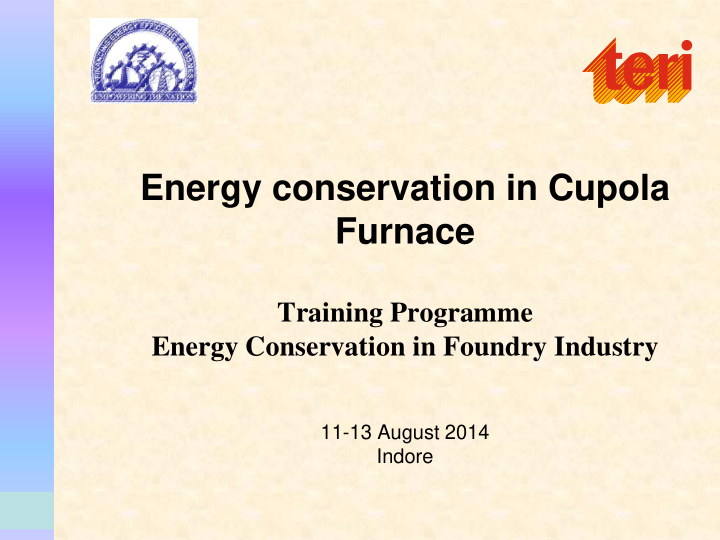



Energy conservation in Cupola Furnace Training Programme Energy Conservation in Foundry Industry 11-13 August 2014 Indore
Areas/Levels of energy savings and investments Area 1: Area 2: Process Auxiliaries Level 1 Operating practice E.g. E.g. improvement Compressed air BOP leakage Level 2 E.g. E.g. Retrofit VFD for screw Retrofit DBC compressor Level 3 E.g. E.g. New plant Invertor compressor New DBC
Cupola Vertical shaft cylindrical furnace Heat released from combustion of coke in the bed melts the metallics Advantages – Lower capital cost – Lower energy cost – Better metallurgical properties promoting machinability
Classifications Cold blast operated cupola Hot blast operated cupola – Benefits if the blast air temperature 400 o C + – Second-hand imported hot blast cupolas are difficult to rebuild and operate Continuous tapped cupola – more energy efficient Intermittently tapped cupola
Important design parameters Blast rate (air volume) of blower Optimum blast rate – 375 ft3/min per sq foot or 115 m3/min per sq metre of cupola cross- sectional area – Blower should deliver 15%-20% more than the optimum blast rate Higher blast rate (very common) – Higher coke consumption – High oxidation losses Lower blast air – Lower heat generation (high coke consumption) – Lower metal temperature – Slower melting
Important design parameters.. contd. Blast air pressure (function of cupola diameter) 2 - 0.0134 D + 39.45 P = 0.005 D Where, P = Blast pressure, inch H 2 0 D = Internal diameter at the melting zone, inches
Lower blast air pressure
Important design parameters ..contd Tuyere number and size Tuyere size determines the velocity of the blast air in the bed – For a cold blast system, the total area of the tuyeres is about 20% of the melting zone area – Size of each tuyere can be calculated by dividing the total tuyere area by the total number of tuyeres Recommended number of tuyeres per row – Cupola internal diameter less than 30 inch: 4 – Cupola internal diameter between 30 inch and 42 inch: 6 – Cupola internal diameter between 42 inch and 60 inch: 8 – Cupola internal diameter between 60 inch and 84 inch: 12 The shape of the tuyere can be either round (preferable) or rectangular
Other design parameters Stack height (tuyere to lower edge of charging door) – 16 ft to 22 ft depending upon its diameter – Well depth Influences the carbon pickup and the metal tapping temperature – Increasing the well depth leads to higher carbon-up but reduces the tapping temperature of the molten metal. – Drop of 1 o C for every inch increase in the well depth
Energy Efficiency Calculation Parameters measured – Bed Coke – Charged coke – Metallics charged – Melting time (blower operating hours) Melting rate (tph) = metallics charged (tons) melting time (hr) Charged coke consumption (%) = Charged coke x 100 Metallics charged
Divided Blast Cupola (DBC) How DBC works – A cooler reduction zone is produced about 1 m above the tuyere due to formation of CO (endothermic reaction) – By introducing secondary air by double row of tuyere reduces CO formation
TERI’s development and demonstration of improved DBC Diagnostic studies to assess energy efficiency and operating practices of existing cupolas Development & demonstration of improved DBC design – Pooling of expertise for technology development • Cast Metals (BCIRA), UK • TERI, India • Sorane Sa, Switzerland Demonstration of best operating practices (BOP)
DBC Advantages of ‘properly designed’ DBC – Reduce coke consumption (20 to 40%) – Increases melting rate (by 1.5 times) – Better metal consistence and chemistry TERI has introduced several innovations in DBC design – Correct specifications of the blower (pressure & flow rate) – Cast iron tuyeres – 10D straight length of blast air mains – Butterfly valves on blast mains and each tuyere – Sight glass on each tuyeres – Higher stack height – Bucket charging
Demonstration Plant at Howrah (West Bengal) Pollution Control System Commissioned 1998 venturi-scrubber DBC – Divided Blast Cupola 100 ft free standing chimney Bucket charging system
Energy efficiency in typical small-scale foundry units 30.0% 26.5% 25.0% Charge coke 20.0% 18.0% 15.8% 14.8% 15.0% 13.6% 8% 10.0% 5.0% 0.0% Single blast DBC (Agra) Single blast DBC - 1 DBC - 2 Demo unit (Agra) (Howrah) (Howrah) (Howrah) (Howrah)
Energy performance Coke charge in CC 13.6% Coke charge in DBC 8.8 % Energy savings 35 % [(13.6 – 8.8)/13.6]
Environment performance
Detailed Fabrication Drawing Design includes Fabrication drawing (of all MS components) Pattern drawings of CI components Specifications of blower Skip hoist design Plant layout
Conventional Cupola to DBC – Rajkot, Gujarat Then and Now
DBC
Technology replication Aquasub, Coimbatore
Spreading the technology to Bangladesh
TERI-PCRA R&D Project – 18” ID DBC
B S Engineers & Founders - DBC
Best operating Practices See BOP film
Energy cost – Induction Vs Cupola Induction furnace • Sp. elec. consumption 650 kWh/tonne • Price of electricity 10 Rs/kWh • Energy cost 6500 Rs Cupola • Coke:Melt 1:10 • Price of coke 30,000 Rs/ton • Energy cost 3000 Rs/ton Savings per ton Rs 3500 Savings per 100 ton Rs 3,50,000
Energy cost – For duplexing operation Only Induction Furnace • Energy cost 6500 Rs/ton Cupola + Induction Furnace • Cupola energy cost 3000 Rs/ton • Induction superheating 100 kWh/tonne or 1000 Rs/ton • Total 4000 Rs/ton Savings per ton Rs 2500 Savings per 100 ton Rs 2,50,000
Thank you for your kind attention! Prosanto Pal TERI , New Delhi prosanto@teri.res.in
Recommend
More recommend